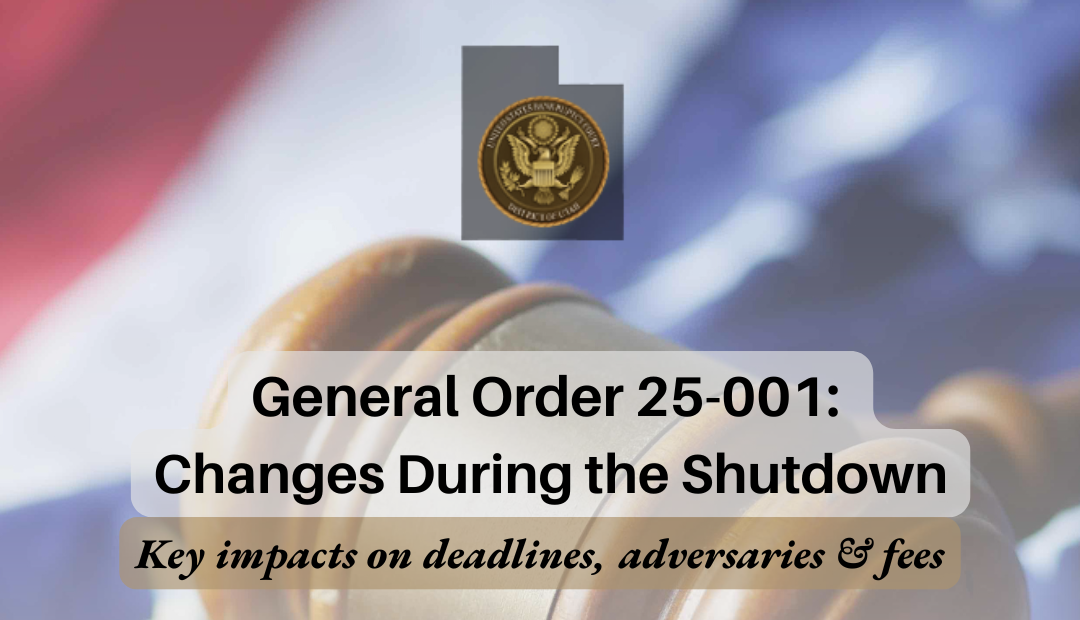On October 8, 2025, the U.S. Bankruptcy Court for the District of Utah issued General Order 25-001 in response to the federal funding lapse that began at midnight on September 30, 2025. The order addresses how the shutdown affects cases and adversary proceedings involving United States agencies, departments, and instrumentalities that appear before the Bankruptcy Court, defined collectively as “Affected Entities,” which include the U.S. Trustee’s Office and the U.S. Attorney’s Office for the District of Utah.
Big Picture
- Cases keep moving. Bankruptcy cases in Utah are not automatically stayed just because an Affected Entity is involved. However, the Court may continue (postpone) contested matters involving Affected Entities on a case-by-case basis. Parties that are not Affected Entities must comply with all orders, laws, deadlines, and hearings as usual, including timely responding to any papers filed by Affected Entities.
- Adversary proceedings with Affected Entities are paused. All adversary proceedings in which an Affected Entity is a party are stayed until an “End Stay Date” the Court will set after funding is restored. Deadlines in those adversaries are extended to the later of 21 days after the End Stay Date or 21 days after the original deadline.
- You can still sue and serve Affected Entities. The order does not prohibit debtors or other parties from filing motions or objections, or even initiating new adversary proceedings against Affected Entities, and service can proceed under Rule 7004. Importantly, any deadlines to file motions or objections or initiate adversary proceedings against Affected Entities are not extended.
Deadlines & Extensions
As stated above, deadlines in adversary proceedings involving Affected Entities are extended to the later of 21 days after the End Stay Date or 21 days after the original deadline.
For obligations that require an Affected Entity to take affirmative action in a bankruptcy case (e.g., filing proofs of claim, administrative expense requests, or objections to fee applications in chapter 11), any deadlines falling on or after October 1, 2025, are likewise extended to the later of:
- 21 days after the End Stay Date, or
- 21 days after the original deadline.
These grace periods do not apply to debtors, creditors, or other non-affected parties. Your deadlines remain in force.
Money Still Must Flow
The order does not alter, vacate, or stay payment obligations owed to Affected Entities, including:
- Quarterly U.S. Trustee fees in chapter 11 under 28 U.S.C. § 1930(a)(6);
- Plan disbursements in chapters 11 and 13; and
- Chapter 7 disbursements required by the Bankruptcy Code.
How the “End Stay Date” Will Be Set
Once funding is restored, at least one Affected Entity must file a notice with the Court.. The Court will then enter a follow-up order establishing the End Stay Date, after which parties will be able to calculate the precise date to which deadlines are extended under the provisions described above.
Ability to Seek Relief
Any party in interest may move to modify or obtain relief from General Order 25-001 if circumstances warrant.
Practical Takeaways
- Debtors and private parties: Assume business as usual for your filings, appearances, and deadlines. Don’t miss hearings or due dates. Continue to respond timely to papers filed by Affected Entities in bankruptcy cases.
- When the U.S. Trustee or other federal party must act: Expect deadline extensions, but plan for hearings to be continued rather than automatically stayed (except adversaries, which are stayed).
- Fees and plan payments: Keep paying — shutdown or not.
General Order 25-001 balances statutory limits on federal employee work during a shutdown with the need to keep bankruptcy administration on track. Until the Court sets an End Stay Date, practitioners should meet all non-government deadlines, continue making required payments, and anticipate extensions where an Affected Entity would otherwise need to act.
Source: U.S. Bankruptcy Court for the District of Utah, General Order 25-001 (filed Oct. 8, 2025).
